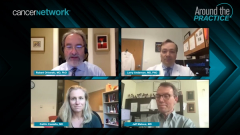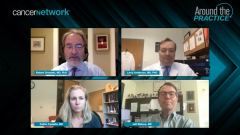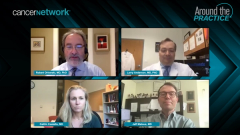
Transplant-Ineligible MM: Navigating Treatment Challenges
A panel of hematologists/oncologists conclude a discussion about transplant-ineligible multiple myeloma (MM) by reacting to current treatment gaps that need to be addressed.
Episodes in this series

Robert Orlowski, MD, PhD: We’re getting toward the end of the program, but before we close, I wanted to cover a couple important questions. What are some unmet medical needs in this population, despite all the great upfront therapy that we have? Larry, what’s your top unmet medical need for these patients?
Larry Anderson, MD, PhD: The top unmet need would be financial toxicity patients that don’t have a good prescription coverage. It’s hard to give these combinations with huge copays. We often rely on assistance programs and those can help a lot, but then some patients just can’t get that. Getting lower-cost medications and able to give this to the masses would be one of the top things.
Robert Orlowski, MD, PhD: Caitlin, if you had to pick one unmet need, what would that be?
Caitlin Costello, MD: High risk. I don’t know what to do with the high-risk patients upfront. Should I be doing something different? I don’t know.
Robert Orlowski, MD, PhD: Jeff, what’s your top?
Jeff Matous, MD: It’s quality of life. It’s avoiding neuropathy and avoiding infections in these older patients in particular.
Robert Orlowski, MD, PhD: I agree with all of you. Just to be a little different, if I had to pick one item, I would want to get an additional novel drug to try to incorporate into frontline therapy, because part of the reason we have to continue treatment is that our current regimens don’t optimally site or reduce patients. One of these days, if we get the best combination, hopefully we won’t have the debate about whether you need to continue treatment or not.
The last question is about how we feel that the treatment landscape may change for newly diagnosed myeloma over the next 5 to 10 years. Again, let’s pick one item that you think will change the most. Let’s start with Larry.
Larry Anderson, MD, PhD: We’re going to be seeing a lot more of the immune therapies—whether it’s bispecifics or CAR Ts [chimeric antigen receptor]—earlier line, if not frontline. And then combinations of immunotherapies with other therapies to try to get that deepest remission, at least in patients that could potentially tolerate these things.
Robert Orlowski, MD, PhD: Caitlin, what’s your top change over the next 5 to 10 years? It’s tough to top more immunotherapy front line.
Caitlin Costello, MD: I guess more specific is we’re going to have BCMA [B-cell maturation antigen] targeted therapies in that front setting, no matter how you do it. And combinations of BCMA and CD-38 at the same time seems exciting. But then what do we do, transplant or CAR T?
Robert Orlowski, MD, PhD: There you go. Jeff, do you have a good one to add to that great list?
Jeff Matous, MD: It’s hard to add on top of Larry and Caitlin, but I would say, are we going to learn about sustained MRD [minimal residual disease] negativity and whether or not we can use fixed duration therapy in certain patients?
Robert Orlowski, MD, PhD: Great topics. If I had to pick one in addition to that, it would be that I do hope that over the next 5 to 10 years, we will be able to do peripheral blood MRD testing and use that to guide therapy.
Well, I wanted to thank all of you for joining us with this program, and especially thank Drs Anderson, Matous, and Costello for joining us. I hope that this has been an informative discussion. It’s certainly been lively, and I hope we’ve covered most, if not all, your questions on transplant-ineligible multiple myeloma (MM). I’d like to thank CancerNetwork® for bringing this program to you, and thank you, again, best wishes and best outcomes for your patients with multiple myeloma. Thank you very much.
Transcript edited for clarity.
Newsletter
Stay up to date on recent advances in the multidisciplinary approach to cancer.





















































































